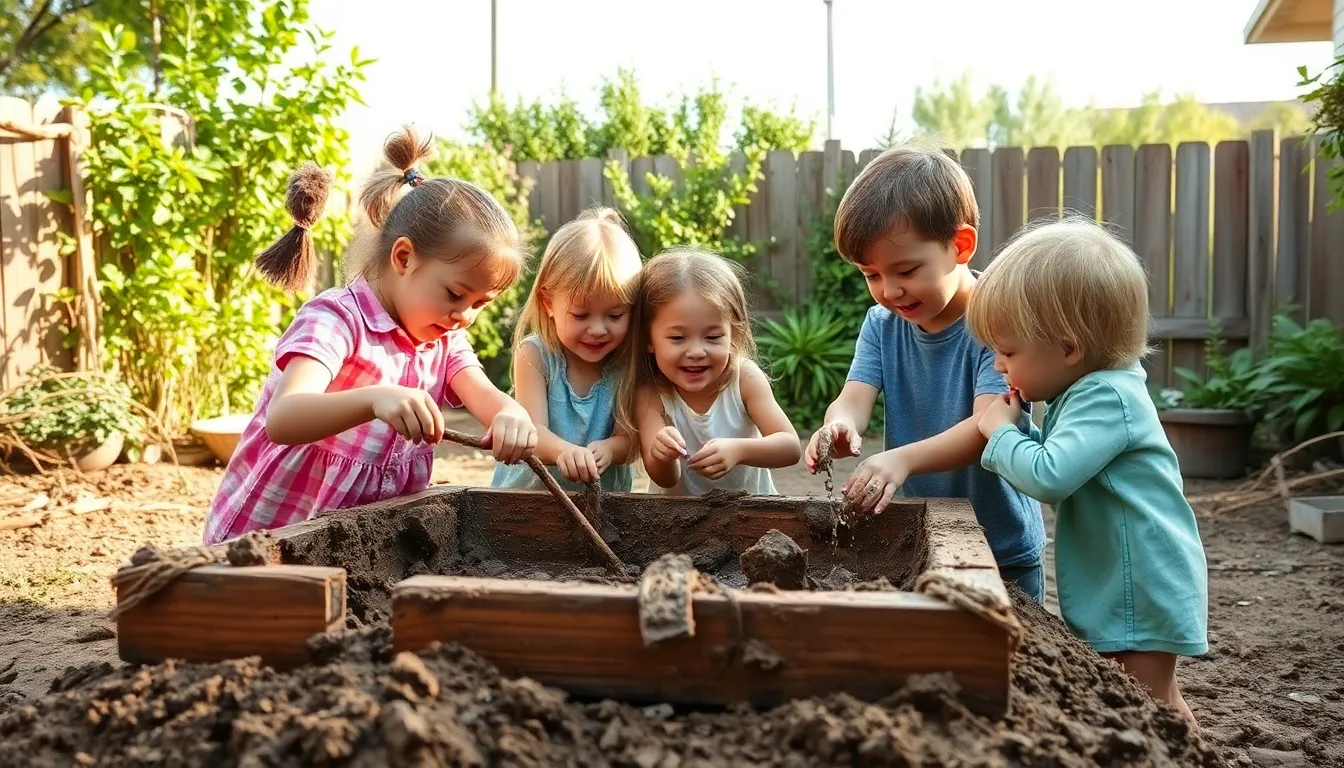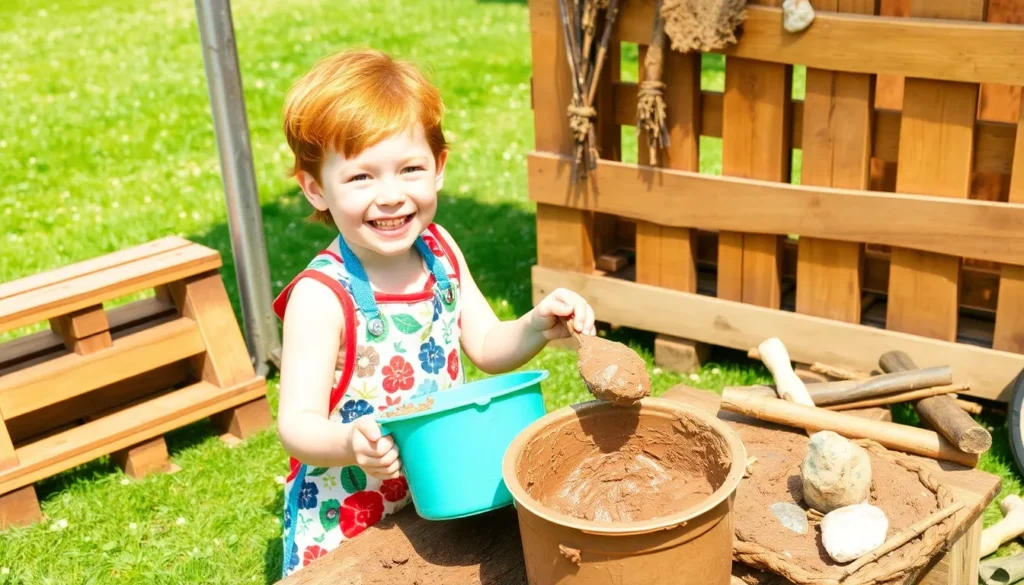Table of Contents
ToggleImagine a world where kids can unleash their inner chefs without the fear of a kitchen disaster—welcome to the magical realm of mud kitchens! These delightfully messy outdoor play spaces turn dirt and water into gourmet creations, sparking creativity and imagination. Who needs fancy cookware when you’ve got a bucket, some sticks, and a whole lot of mud?
What Are Mud Kitchens?
Mud kitchens serve as outdoor play areas specifically designed for children. These spaces encourage imaginative culinary activities using natural materials such as mud, dirt, and water. Creativity takes center stage as kids mix, pour, and experiment with simple items like buckets, sticks, and pots.
Outdoor mud kitchens promote sensory play. Engaging with different textures and smells enhances children’s cognitive and motor skills. They often set up their own cooking stations, allowing for collaborative play, social interaction, and the exchange of ideas.
Varieties of mud kitchens exist, ranging from simple setups to elaborate installations. Some designs feature built-in tables, sinks, and shelves, creating a more structured environment. Others rely on natural elements, providing flexibility for children’s imaginations to flourish.
Benefits extend beyond creativity. Children develop problem-solving skills as they navigate how to create their dishes. Messy play helps build resilience, as they learn to embrace failures and successes alike. Engaging with nature fosters a connection to the outdoor environment, enhancing their overall developmental experience.
Safety remains a fundamental consideration. Mud kitchens allow for exploration in a controlled manner, reducing hazards that typical indoor kitchens present. Parents and educators often supervise play, ensuring children engage safely while still enjoying the freedom of outdoor creativity.
These kitchens enhance play-based learning. They serve as a bridge between imaginative fun and educational experiences, helping children understand concepts such as measurement, pouring, and mixing. Mud kitchens combine enjoyment with valuable life skills, making them a unique and enriching addition to outdoor play spaces.
Benefits of Mud Kitchens

Mud kitchens offer numerous advantages that go beyond simple outdoor fun. Children experience a variety of developmental benefits through engaging with these creative spaces.
Encouraging Creativity
Creative expression flourishes within mud kitchens. Kids transform natural elements like soil and water into imaginative dishes, fostering original thinking. Imagination drives play, as children experiment with textures and colors. They mix mud and water to create various ‘food’ items. Collaborative play occurs when children work together, generating unique culinary ideas. Setting up their own kitchens encourages independence and decision-making. Simple items like sticks and stones serve as utensils, widening creative possibilities. These kitchens become platforms for storytelling and role play, enhancing narrative skills.
Promoting Outdoor Play
Outdoor experiences thrive in mud kitchens. Fresh air and physical activity stimulate both body and mind. Children engage in active play, climbing, running, and digging while creating their mud masterpieces. Natural spaces provide opportunities for sensory exploration, connecting kids to their environment. Outdoor play encourages social interactions, helping children build friendships through shared experiences. The flexible environment nurtures problem-solving abilities as children navigate challenges like creating stable structures. Every mud kitchen becomes a canvas, allowing kids to explore the outdoors while developing crucial life skills. Enhancing playtime through the outdoors promotes overall well-being.
How to Build a Mud Kitchen
Building a mud kitchen involves a few key steps for creating a fun and engaging space for children.
Essential Materials
Select materials that encourage creativity and withstand outdoor conditions. Wooden pallets or crates serve as excellent bases, providing various heights for different play styles. Include pots, pans, and utensils, ideally made from stainless steel or silicone to ensure durability. Incorporate natural elements like rocks, branches, and soil for a more immersive experience. Water sources, such as buckets or bins, allow kids to experiment with mixing. Consider non-toxic paint or sealants to protect wooden surfaces, ensuring safety. Collecting these materials beforehand streamlines the building process.
Design Ideas
Consider various design ideas to match the play environment. A simple structure might feature a countertop area with shelves beneath for storage. Incorporating a water station boosts imaginative play, where children can wash their creations. Add a chalkboard section for menu writing or recipe ideas, enhancing literacy engagement. Creating designated cooking zones for different activities, like a baking corner or a soup area, encourages diverse experiences. Lastly, paint and decorate the kitchen to make it visually appealing, inviting children into their culinary world.
Safety Considerations
Safety plays a crucial role in mud kitchens. Ensure children have access to non-toxic materials, preventing exposure to harmful substances. Supervision remains essential, particularly during messy play, to mitigate potential accidents and ensure safe interactions.
Equipment selection impacts safety as well. Choose sturdy, weather-resistant materials for longevity and stability. Wooden structures require regular inspections to prevent splinters and decay. Non-slip surfaces help reduce the risk of falls, especially in wet conditions.
A designated area for mud kitchens enhances safety. Establish clear boundaries to define the cooking space, minimizing distractions from nearby hazards. Parents and educators can encourage children to wash hands thoroughly before and after play to maintain hygiene.
Educators should teach children about safe play practices. Explain proper usage of tools, such as buckets or shovels, to avoid accidents. Encourage collaboration during play, facilitating discussions about taking turns and sharing resources responsibly.
Incorporating safety features enhances the overall experience. Installing low fences or barriers can deter unintended access, protecting children from adjacent hazards. Additionally, placing a first aid kit nearby ensures quick access in case of minor injuries.
Understanding local regulations helps maintain safety standards. Verify that the mud kitchen complies with guidelines for outdoor play spaces. Frequent maintenance checks keep the environment safe and inviting, ensuring that children can explore their culinary creativity without unnecessary risks.
Mud kitchens are more than just outdoor play spaces; they’re gateways to creativity and learning. By encouraging messy play with natural materials, these kitchens foster essential skills like problem-solving and collaboration. They provide a safe environment for children to explore their culinary imaginations while connecting with nature.
With various design options available, building a mud kitchen can be a fun project for families and educators alike. The benefits of mud kitchens extend beyond play, enriching children’s lives through sensory experiences and social interactions. As children engage in this creative play, they develop not only their motor skills but also a sense of resilience and friendship.
Incorporating a mud kitchen into outdoor play areas can transform a simple backyard into a vibrant learning environment, making it a delightful addition to any child’s playtime.







